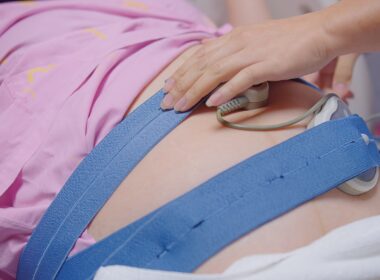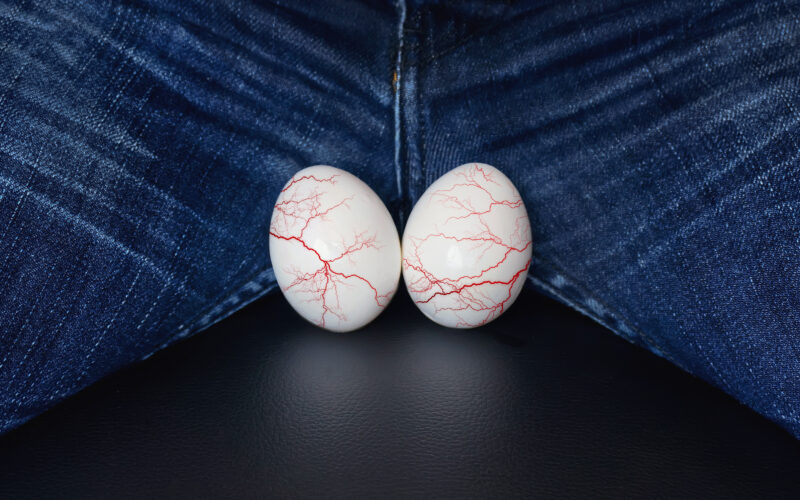Staying up late researching varicoceles? Your worrying may turn out to be in “vein” (if this pun doesn’t make sense, just keep reading). Varicoceles are very common, and usually require no treatment. But, for men who experience infertility, varicoceles are a frequent–but treatable–culprit. Here we cover when to call the doctor and what to know about treatment options like varicocelectomy.
What is a varicocele?
The term varicocele comes from “varico” meaning dilated vein–just like in varicose veins, those protruding, twisted veins that sometimes form in the legs–and “cele” meaning tumor. But a varicocele is not a tumor. It’s what happens when the pampiniform plexus veins inside the scrotum become swollen and enlarged. “Tumor” was the historical diagnosis before our modern understanding of varicocele development.
The exact cause of this phenomenon is not known, but several main theories exist. The vein may become “trapped” in between two other vessels and put pressure on the vein and restrict blood flow, causing enlargement [1]. Or, the valve inside the vein may not work properly, causing blood to pool in the vein (similar to the development of varicose veins in the legs) [1]. Thirdly, the vein may naturally sit at a bit of an angle that makes it harder for blood to flow out [1].
Varicoceles are most common in men ages 15–25, likely because the testicles require more blood as they mature during puberty. Increased blood flow is hard for the vein to handle if an anatomical quirk makes it harder for the vein to properly drain. A varicocele is generally not dangerous and often goes unnoticed. But some varicoceles may feel uncomfortable when blood pressure is elevated, like in hot weather or during exercise. In rare cases, a varicocele can severely decrease testosterone levels and cause complications.
Varicocele diagnosis and treatment
Approximately 1 in 6 men have a varicocele, so most varicoceles probably don’t impact daily life. However, 40% of men seeking treatment for infertility are diagnosed with a varicocele. A varicocele can usually be detected in a routine physical exam. Smaller varicoceles may require special imaging technology, such as ultrasound or thermography (using infrared aka thermal imaging), to detect. Varicoceles can contribute to abnormal semen (sperm plus ejaculation fluid) because the pooled blood can increase the temperature of the testes. A difference of just a few degrees can damage or kill sperm. Damaged sperm usually demonstrate a “stress pattern” of low sperm count, poor motility (ability for the sperm to “swim”), and abnormal structure [1]. With sperm counts decreasing worldwide, a varicocele could further contribute to a man’s impaired fertility.
Varicocelectomy Surgery
There are non-surgical ways to ease discomfort from a varicocele, like applying ice, taking ibuprofen, or wearing snug underwear. But if a varicocele is persistently uncomfortable or if it is suspected to be impacting fertility, there are simple outpatient procedures to treat the varicocele long-term and redirect blood to normally functioning veins instead. The first is microscopic varicocelectomy (“-ectomy” means “removal”) in which a surgeon utilizes a microscope and makes a small cut above the scrotum and ties off the affected veins, while avoiding the other structures. The procedure typically takes 2-3 hours. In a laparoscopic varicocelectomy, the surgeon inserts a laparoscope, or small camera, to identify the affected veins and then he or she will tie off the affected veins; this procedure can be done in 30-40 minutes.
Percutaneous embolization
There is also a non-surgical option called percutaneous embolization. A catheter (small tube) is inserted into a vein through a tiny incision, using contrast dye and x-ray guidance to locate the varicocele. A small coil is then inserted into the veins that feed the varicocele to their block blood flow. Regardless of technique, recurrence is a possibility. This means the procedure may need to be repeated, or a different procedure may need to be used, especially if desired fertility has not been restored.
Will varicocele return after varicocelectomy surgery or embolization?
According to a 2016 literature review, the overall recurrence rate for the microscopic approach is about 1.05%, 4.3% for the laparoscopic approach, and 12.7% for embolization [2]. As with any surgical procedure, it is important to take the pros and cons of all the available options into account when making a treatment plan. In cases of recurrence, further procedures would only be attempted if infertility continues or if symptoms recur or persist.
What else can be done to support male fertility?
Like the female reproductive system, the male reproductive system is a complex system of hormones that impact and are influenced by the other organ systems. Male infertility can be just as complicated and difficult to deal with as female infertility. Thankfully, varicoceles are one cause of infertility that come with straightforward options that may help improve sperm count and motility.
Healthy habits to naturally support sperm production include: make the pelvis region a radiation-free zone (which in day-to-day life really just means keeping cell phones out of the front pockets and avoiding excess heat), maintain a healthy weight, and consume foods high in antioxidants and vitamins. just to name a few.
Infertility is a stressful, confusing, and painful experience for many couples. And while physical treatments can take a toll, the mental-emotional experience of infertility can be profound. Just as varicocele treatment addresses the root cause of the issue, hopefully women’s healthcare will continue to shift to an approach to infertility that effectively treats its root causes, and supports men and women and their whole-person health.
Resources:
[1] Leslie SW, Sajjad H, Siref LE. Varicocele. [Updated 2023 Mar 11]. In: StatPearls [Internet]. Treasure Island (FL): StatPearls Publishing; 2023 Jan-. Available from: https://www.ncbi.nlm.nih.gov/books/NBK448113/ [2] Rotker K, Sigman M. Recurrent varicocele. Asian J Androl. 2016 Mar-Apr;18(2):229-33. doi: 10.4103/1008-682X.171578. PMID: 26806078; PMCID: PMC4770491.Additional Reading:
Male infertility: are low sperm counts a big deal?
Why we really need better options for treating male infertility
Natural treatment options for male infertility
“Is infertility treatable?” and other questions: A Natural Womanhood Infertility FAQ







